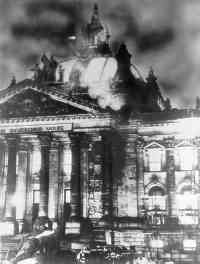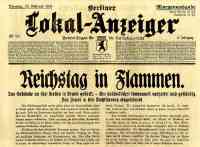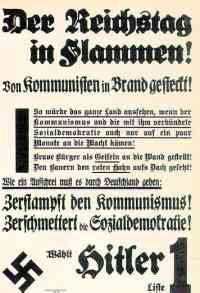

EXCLUSIVE: To Provoke War, Cheney Considered Proposal To Dress Up Navy Seals As Iranians And Shoot At Them
Speaking at the Campus Progress journalism conference earlier this month, Seymour Hersh — a Pulitzer-Prize winning journalist for The New Yorker — revealed that Bush administration officials held a meeting recently in the Vice President’s office to discuss ways to provoke a war with Iran.
In Hersh’s most recent article, he reports that this meeting occurred in the wake of the overblown incident in the Strait of Hormuz, when a U.S. carrier almost shot at a few small Iranian speedboats. The “meeting took place in the Vice-President’s office. ‘The subject was how to create a casus belli between Tehran and Washington,’” according to one of Hersh’s sources.
During the journalism conference event, I asked Hersh specifically about this meeting and if he could elaborate on what occurred. Hersh explained that, during the meeting in Cheney’s office, an idea was considered to dress up Navy Seals as Iranians, put them on fake Iranian speedboats, and shoot at them. This idea, intended to provoke an Iran war, was ultimately rejected:
HERSH: There was a dozen ideas proffered about how to trigger a war. The one that interested me the most was why don’t we build — we in our shipyard — build four or five boats that look like Iranian PT boats. Put Navy seals on them with a lot of arms. And next time one of our boats goes to the Straits of Hormuz, start a shoot-up.
Might cost some lives. And it was rejected because you can’t have Americans killing Americans. That’s the kind of — that’s the level of stuff we’re talking about. Provocation. But that was rejected.
Watch it:
Hersh argued that one of the things the Bush administration learned during the encounter in the Strait of Hormuz was that, “if you get the right incident, the American public will support” it.
“Look, is it high school? Yeah,” Hersh said. “Are we playing high school with you know 5,000 nuclear warheads in our arsenal? Yeah we are. We’re playing, you know, who’s the first guy to run off the highway with us and Iran.”
Transcript:
HERSH: There was a meeting. Among the items considered and rejected — which is why the New Yorker did not publish it, on grounds that it wasn’t accepted — one of the items was why not…
There was a dozen ideas proffered about how to trigger a war. The one that interested me the most was why don’t we build — we in our shipyard — build four or five boats that look like Iranian PT boats. Put Navy seals on them with a lot of arms. And next time one of our boats goes to the Straits of Hormuz, start a shoot-up. Might cost some lives.
And it was rejected because you can’t have Americans killing Americans. That’s the kind of — that’s the level of stuff we’re talking about. Provocation. But that was rejected.
So I can understand the argument for not writing something that was rejected — uh maybe. My attitude always towards editors is they’re mice training to be rats.
But the point is jejune, if you know what that means. Silly? Maybe. But potentially very lethal. Because one of the things they learned in the incident was the American public, if you get the right incident, the American public will support bang-bang-kiss-kiss. You know, we’re into it.
…What happened in the Gulf was, in the Straits, in early January, the President was just about to go to the Middle East for a visit. So that was one reason they wanted to gin it up. Get it going.
Look, is it high school? Yeah. Are we playing high school with you know 5,000 nuclear warheads in our arsenal? Yeah we are. We’re playing, you know, who’s the first guy to run off the highway with us and Iran.
If this story sounds familiar, that's because it is. In one of David Manning's famous memos describing a prewar meeting between George Bush and Tony Blair, he says that Bush admitted that WMD was unlikely to be found in Iraq and then mused on some possible options for justifying a war anyway:"The U.S. was thinking of flying U2 reconnaissance aircraft with fighter cover over Iraq, painted in U.N. colours," the memo says, attributing the idea to Mr. Bush. "If Saddam fired on them, he would be in breach."In the end, of course, we didn't do this. We just didn't bother with any pretext at all.
 Poland in World War II September 1, 1939 - May 8, 1945
Poland in World War II September 1, 1939 - May 8, 1945The world in August 1939 was a world that held its breath. Fighting had ended in Spain, and the war in China had stagnated. But few people believed war would be avoided
What was not certain was where and when. Adolf Hitler enjoyed tremendous popularity at home, and pro-Nazi factions were active in the United States, France, and Great Britain. His recent occupation of Czechoslovakia had raised alarms in capitals across Europe, even though many people ignorant of the violence and terror of the German political machine still looked to Hitler as a role model for their own governments.
Then the unthinkable happened. Joaquim von Ribbentrop, Hitler’s Foreign Minister, went to Moscow the last week of August to secure a Nazi-Soviet Nonaggression Pact. Stalin, perhaps trying to buy time with Hitler himself, ordered his Foreign Minister, Molotov, to sign on August 21, 1939. When this agreement was announced to the world, it left out some key terms: the dismemberment of Poland.
Anyone reading Mein Kampf could see what Hitler thought of Poland. A former province of Czarist Russia, Poland had been guaranteed access to the sea — the “Free Corridor” of Danzig — by the League of Nations. This agreement separated Prussia from Greater Germany by cutting a path through to the seaport of Danzig. This angered Hitler and many Germans, who saw the land as the birthright of Germans everywhere.
Moreover, Poland was not an Aryan land. Poles were untermensch, “inferior people,” only good as slaves or corpses. After the dismemberment of Czechoslovakia, Hitler ordered his general staff to draw up plans for the invasion of Poland. The Germans would invade from the West, the Soviets from the East, and divide the country along previously agreed upon lines.
The SS took twelve prisoners out of Buchenwald, drove them to the Polish border and forced them to take poison after putting on Polish uniforms. The corpses were shot. An SS Officer yelled in Polish into a radio that they had come to invade Germany, and then the SS fled.
On September 1, 1939, Hitler told the Nazi Reichstag that Poland had tried to invade Germany, and the Wehrmacht was returning fire since 5:45 AM. Actually, in a carefully planned and highly mobile attack codenamed Fall Weiss (Case White) planned by Generalfeldmarschall Walther von Brauchitsch, German land, sea, and air forces were moving rapidly into Poland.
Poland’s army in 1939 was totally unprepared for the new warfare it found itself in. Poland, like many armies, had large cavalry forces. What modern aircraft the Polish Air Force had were caught on the ground.
England and France wearily knew that they could not sacrifice Poland the way Czechoslovakia had been. On September 3, 1939, the Allies declared war against National Socialist Germany. The declaration did not save Poland. Lodz was about to fall, and Krakow fell on September 6. The fort at Danzig fell on September 7, after a week of direct fire from German battleships.
After a surprise Polish maneuver inflicted heavy casualties, the Germans rallied and took 100,000 prisoners. By September 16, German artillery ringed Warsaw, and the Nazis gave the Poles an ultimatum: surrender or face bombardment. The Poles demurred, and endured heavy shelling until September 27. German troops occupied Warsaw on October 1.
On September 17, Soviet troops entered Western Poland. They stopped at Brest-Litovsk, where Germans had allowed the Bolsheviks to withdraw from World War I. Again the two nations carved up Poland.
Organized Polish resistance ended on October 6, 1939. Some 100,000 Polish soldiers would escape to form the Free Polish Brigade in England, where they would fight in the air during the Battle of Britain and on land after the Normandy invasion.
The Nazis appointed former SA stormtrooper Hans Frank to Gauleiter (Governor General) of Poland. Under his direction over 6,000,000 Poles died, including 3,000,000 Jews.
As the Red Army approached Warsaw during their 1944 offensive, Stalin ordered a halt. The pro-west Polish Home Army was destroyed by the Germans. Only after the western Poles were annihilated did the Red Army resume the advance.
As Germany was near collapse in 1945, most of the forced laborers in Germany were French. There were no longer enough Poles left alive to feed Germany’s slave labor requirements.

Burning the Reichstag
From SourceWatch
On the 27. February in 1933, one month after Adolf Hitler was declared Reichskanzler, the Reichstags-building in Berlin was burning.
As well as Marinus van der Lubbe the German police charged four communists with setting fire to the Reichstag. This included Ernst Torgler, the chairman of the KPD and Georgi Dimitrov of the Soviet Comintern.
Marinus van der Lubbe was found guilty of the Reichstag Fire and was executed on 10th January, 1934. Adolf Hitler was furious that the rest of the defendants were acquitted and he decided that in the future all treason cases were to be taken from the Supreme Court and given to a new People's Court where prisoners were judged by members of the National Socialist German Workers Party (NSDAP).
The burning of the Reichstag was very useful for the German Government. On the 28. of February, the Reichstagsbrandverordnung (similiar to Patriot Act) was set in power.
This Decree of the Reich President for the Protection of the People and State abrogates the following constitutional protections.
- Free expression of opinion
- Freedom of the press
- Right of assembly and association
- Right to privacy of postal and electronic communications
- Protection against unlawful searches and seizures
- Individual property rights
- Federal States' right of self-government
A supplemental decree creates the SA (Storm Troops) and SS (Special Security) Federal police agencies.
ANALYSIS
The events in 1933 can be summarized as follows:
- While it is not clear whether the Nazis intentionally set the Reichstag fire in order to create a national crisis, or whether the Nazis simply were opportunistic, the event was used as justification for a sharp curtailment in constitutionally guaranteed civil liberties.
- The Nazis took advantage of the additional Federal police powers to suppress opponents.
- It is clear that in other situations, the Nazis did use the tactic of creating a "law and order" crisis so that they could provide a solution which further eroded civil liberties and entrenched their power.
- The right-wing Nazis and the left-wing communists were cut from the same cloth -- the point is not that the far right destroyed civil rights. Rather, the point is that a democracy can be destroyed by creating a law-and-order crisis and offering as a 'solution' the abdication of civil liberties and state's rights to a powerful but unaccountable central authority.






No comments:
Post a Comment